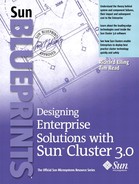System Installation and Configuration Documentation
Initially, all system platforms can be accessed only through the OpenBoot™ PROM (OBP) prompt. After the system platform is correctly connected to the tape, disks, networks, and printers, the applications are installed in a series of sequential steps. The Sun Professional ServicesSM group provides runbook services that produce detailed documentation and include suggested procedures to assist in configuring and managing a system platform.
The simplified system installation sequence is:
1. |
Install the Solaris operating environment. |
2. |
Install the recommended Solaris operating environment patches. |
3. |
Configure the operating environment tunable parameters in /etc/system. |
4. |
Configure the networks, tape, printers, and disks. |
5. |
Install and configure the volume manager. |
6. |
Install the recommended volume manager patches installation. |
7. |
Configure the system user. |
8. |
Install and configure the software applications. |
9. |
Install the recommended patches for the software applications. |
Documenting any discrepancies or irregularities in this process is important because this documentation may prove invaluable as a resource for disaster recovery.
If all of the steps in the application installation are correctly documented, you can use this documentation to regenerate an entire system from scratch if disaster strikes. Additionally, you can use the system documentation to educate system administrators or to provide material for an implementation review.
Note
A documented backup and disaster recovery plan for all critical systems is important. Provide hard copy documentation as a backup to online documentation.
Some system administrators use the script(1) utility to capture the input and output generated during a software installation session. However, the script(1) approach generates excessive text, which can bury important content, and it lacks comments explaining why things must be done a particular way. However, a script(1) output can be edited to create an HTML document with appropriate comments. User responses can be highlighted by an alternate font or text style.
Sun provides the Solaris JumpStart product as an option to install system software and application components from the boot prompt without the risk of errors introduced by human interaction. Originally intended for installing the Solaris operating environment, the JumpStart framework can be extended to include almost any software or local modifications. The Solaris 8 4/01 operating environment release added a feature called Web Start Flash technology. This technology enables a prototype or existing system to be stored as a flash archive (flar) and subsequently installed by an automated JumpStart process. The installation is optimized to minimize the installation time and is significantly faster than installing with the pkgadd facility used for most JumpStart installations. The Web Start Flash technology is ideal for cloning or archiving systems.
Note
A best practice is to have the JumpStart framework automatically regenerate the entire system software infrastructure to enable recovery from any local disaster. You can use the JumpStart Flash technology to easily jump-start a heavily customized Solaris operating environment system.
